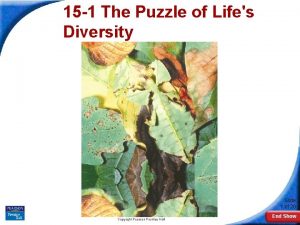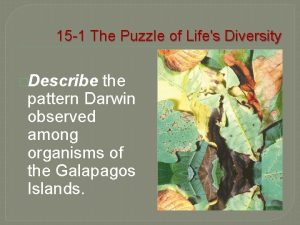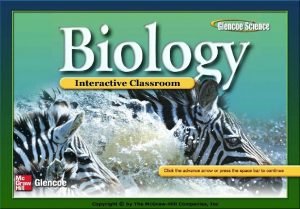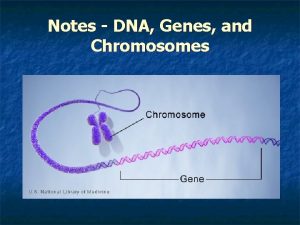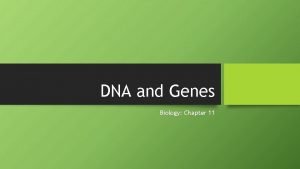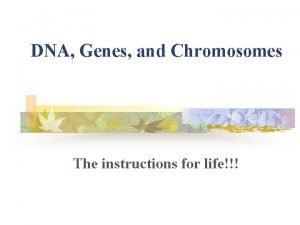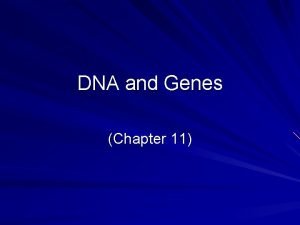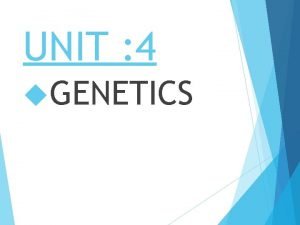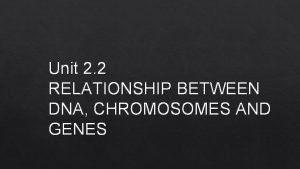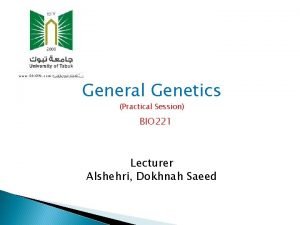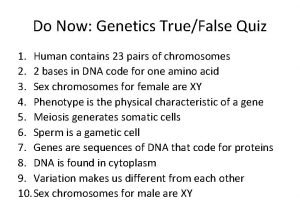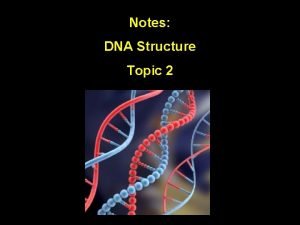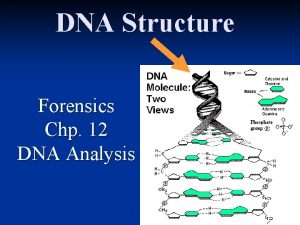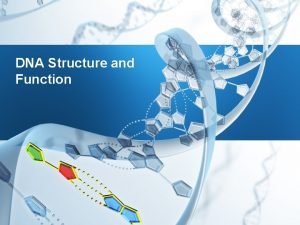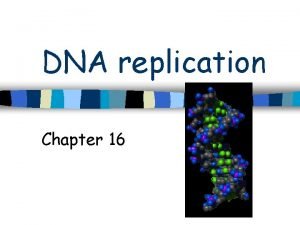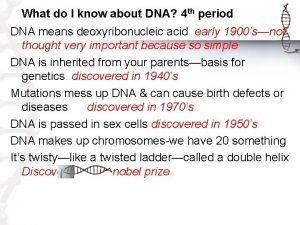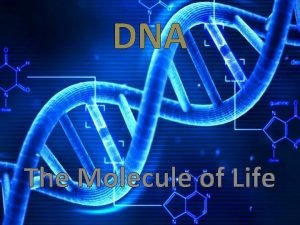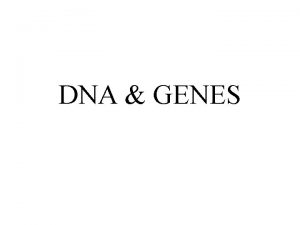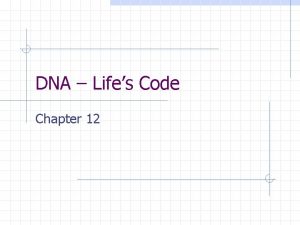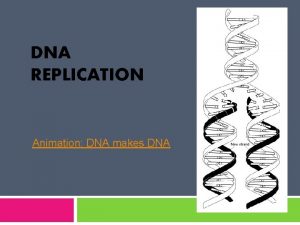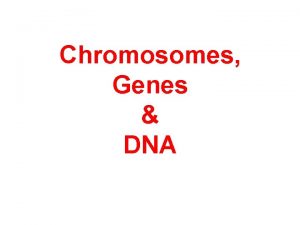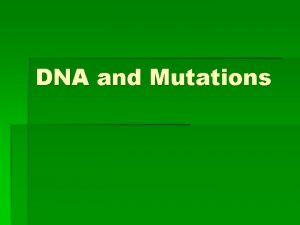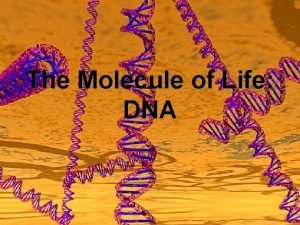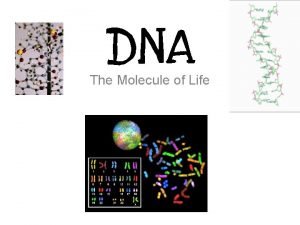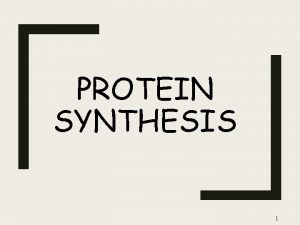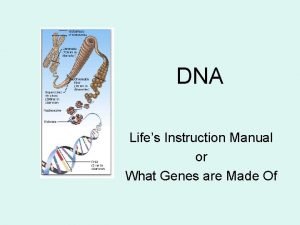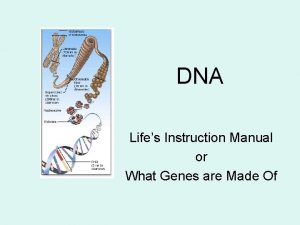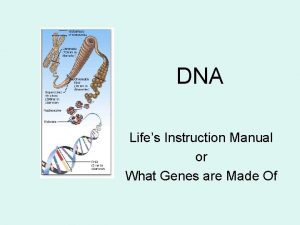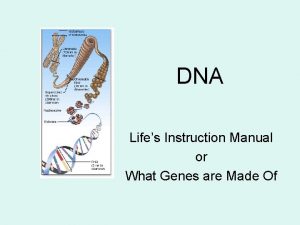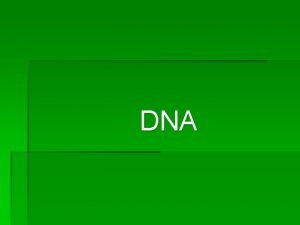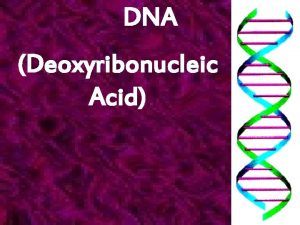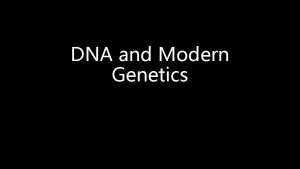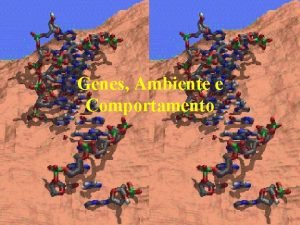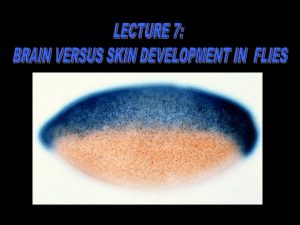DNA lifes code molecule that makes up genes






























- Slides: 30

DNA – life’s code molecule that makes up genes and determines the traits of all living things

Importance of DNA n Controls by: producing proteins n Proteins are important because n All structures are made of protein n n Skin Muscles Bones All actions depend on enzymes (special kind of protein) n n Eating Running Thinking All life activities n Structure contains the complete instructions for making all proteins

DNA Structure n Stands for deoxyribonucleic acid n Double helix = twisted ladder = linked nucleotides

DNA Structure - nucleotide n Made of 3 things: n Deoxyribose n Phosphoric acid n Nitrogen bases

DNA Structure – nitrogen bases n Four types: n Adenine n Cytosine n Guanine n Thymine n A nucleotide is named for the nitrogen base it contains

Linking Nucleotides n Nucleotides join together to make DNA – complementary base pairing n Adenine fits with Thymine n A–T n Cytosine fits with Guanine n C–G

How DNA is packaged

Figure 12 -10 Chromosome Structure of Eukaryotes Human cells contain over one meter of DNA! How? Section 12 -2 Chromosome Nucleosome DNA double helix Coils Supercoils Histones Wrapped around proteins (histones and nucleosomes) Go to Section:

Interest Grabber Section 12 -2 n A Perfect Copy n When a cell divides, each daughter cell receives a complete set of chromosomes. This means that each new cell has a complete set of the DNA code. Before a cell can divide, the DNA must be copied so that there are two sets ready to be distributed to the new cells. Go to Section:

Interest Grabber continued Section 12 -2 1. On a sheet of paper, draw a curving or zig-zagging line that divides the paper into two halves. Vary the bends in the line as you draw it. Without tracing, copy the line on a second sheet of paper. 2. Hold the papers side by side, and compare the lines. Do they look the same? 3. Now, stack the papers, one on top of the other, and hold the papers up to the light. Are the lines the same? 4. How could you use the original paper to draw exact copies of the line without tracing it? 5. Why is it important that the copies of DNA that are given to new daughter cells be exact copies of the original? Go to Section:

Section Outline Section 12 -2 n 12– 2 Chromosomes and DNA Replication A. DNA and Chromosomes 1. DNA Length 2. Chromosome Structure B. DNA Replication 1. Duplicating DNA 2. How Replication Occurs Go to Section:

DNA Replication n Making a chromosome copy n One strand two identical strands n Steps: n n n DNA “unzips” Free nucleotides attach to complementary bases Bonds form between nucleotides creating two identical strands

Figure 12– 11 DNA Replication Section 12 -2 New strand Original strand DNA polymerase Growth Replication fork Nitrogenous bases Replication fork New strand Go to Section: Original strand

n DNA replication n http: //www. stolaf. edu/people/giannini/flashani mat/molgenetics/dna-rna 2. swf

http: //www. wwnorton. com/college/biology/discoverbio 3/full/content/ch 12/animations. asp http: //www. youtube. com/watch? v=zd. Dki. Rw 1 Pd. U&feature=related

RNA vs. DNA

Concept Map Section 12 -3 RNA can be Messenger RNA also called Transfer RNA which functions to m. RNA Carry instructions from to DNA Ribosome also called which functions to t. RNA Bring amino acids to ribosome

Protein Synthesis n Make proteins n Two steps: n Transcription: copying your DNA (genes) into messenger RNA (m. RNA). n Translation: turning messenger RNA (m. RNA) into proteins make up cells.

Transcription Section 12 -3 Adenine (DNA and RNA) Cystosine (DNA and RNA) Guanine(DNA and RNA) Thymine (DNA only) Uracil (RNA only) RNA polymerase RNA DNA

http: //www. youtube. com/watch? v=Ot. Yz_3 rkv. Pk

The Genetic Code Section 12 -3 :

Translation Nucleus Messenger RNA is transcribed in the nucleus. Phenylalanine t. RNA The m. RNA then enters the cytoplasm and attaches to a ribosome. Translation begins at AUG, the start codon. Each transfer RNA has an anticodon whose bases are complementary to a codon on the m. RNA strand. The ribosome positions the start codon to attract its anticodon, which is part of the t. RNA that binds methionine. The ribosome also binds the next codon and its anticodon. Ribosome : m. RNA Transfer RNA Methionine m. RNA Lysine Start codon

Translation (continued) The Polypeptide “Assembly Line” The ribosome joins the two amino acids— methionine and phenylalanine—and breaks the bond between methionine and its t. RNA. The t. RNA floats away, allowing the ribosome to bind to another t. RNA. The ribosome moves along the m. RNA, binding new t. RNA molecules and amino acids. Lysine Growing polypeptide chain Ribosome t. RNA m. RNA Completing the Polypeptide m. RNA Ribosome Translation direction The process continues until the ribosome reaches one of the three stop codons. The result is a growing polypeptide chain.

Transcription DNA Splits In nucleus “Unzipping” Messenger RNA (m. RNA) copies DNA and DNA reforms ladder Translation Transfer RNA (t. RNA) copy m. RNA and make proteins Travels to ribosome

http: //www. youtube. com/watch? v=B 6 O 6 u. Rb 1 D 38

Transcription Animation

Translation

Gene Mutations: Substitution, Insertion, and Deletion Section 12 -4 Substitution Insertion Deletion Point mutation- mutations that affect one nucleotide; generally change one amino acid in a protein (ex: substitution) n Frameshift mutations (Insertion and Deletion) cause much bigger changes since the sequence is read in 3 base codons, everything is now moved over one spot n Go to Section:

Section 12 -4 Figure 12– 20 Chromosomal Mutations Deletion Duplication Inversion Translocation Go to Section: - Involve changes in the number or structure of chromosomes - May change the location of genes and even the number of copies of some genes

Typical Gene Structure Section 12 -5 Regulatory sites Promoter (RNA polymerase binding site) Start transcription Go to Section: A typical gene includes start and stop signals, with the nucleotides to be translated in between DNA strand Stop transcription
 Linked genes and unlinked genes
Linked genes and unlinked genes What are homeotic genes
What are homeotic genes Polygenic inheritance
Polygenic inheritance The puzzle of life's diversity
The puzzle of life's diversity Section 15-1 the puzzle of lifes diversity
Section 15-1 the puzzle of lifes diversity Chapter 17 section 1 the history of classification
Chapter 17 section 1 the history of classification Circle lifes
Circle lifes 4 lifes
4 lifes When upon life's billows
When upon life's billows The relationship between genes dna and chromosomes
The relationship between genes dna and chromosomes Chapter 11 dna and genes
Chapter 11 dna and genes Dna, genes and chromosomes relationship
Dna, genes and chromosomes relationship Dna and genes chapter 11
Dna and genes chapter 11 Genes chromosomes dna
Genes chromosomes dna What is the relationship between dna chromosomes and genes
What is the relationship between dna chromosomes and genes What is agene
What is agene Dna genes
Dna genes Dna chromosomes genes diagram
Dna chromosomes genes diagram Dna rna protein synthesis homework #2 dna replication
Dna rna protein synthesis homework #2 dna replication Dna labeled diagram
Dna labeled diagram Dna molecule two views
Dna molecule two views Dna parts
Dna parts Dna molecule two views
Dna molecule two views Dna prokaryot
Dna prokaryot Dna molecule
Dna molecule Dna structure
Dna structure The molecule dna contains the four bases listed below.
The molecule dna contains the four bases listed below. Dna the molecule of life
Dna the molecule of life Phân độ lown ngoại tâm thu
Phân độ lown ngoại tâm thu Block nhĩ thất độ 3
Block nhĩ thất độ 3 Thể thơ truyền thống
Thể thơ truyền thống



